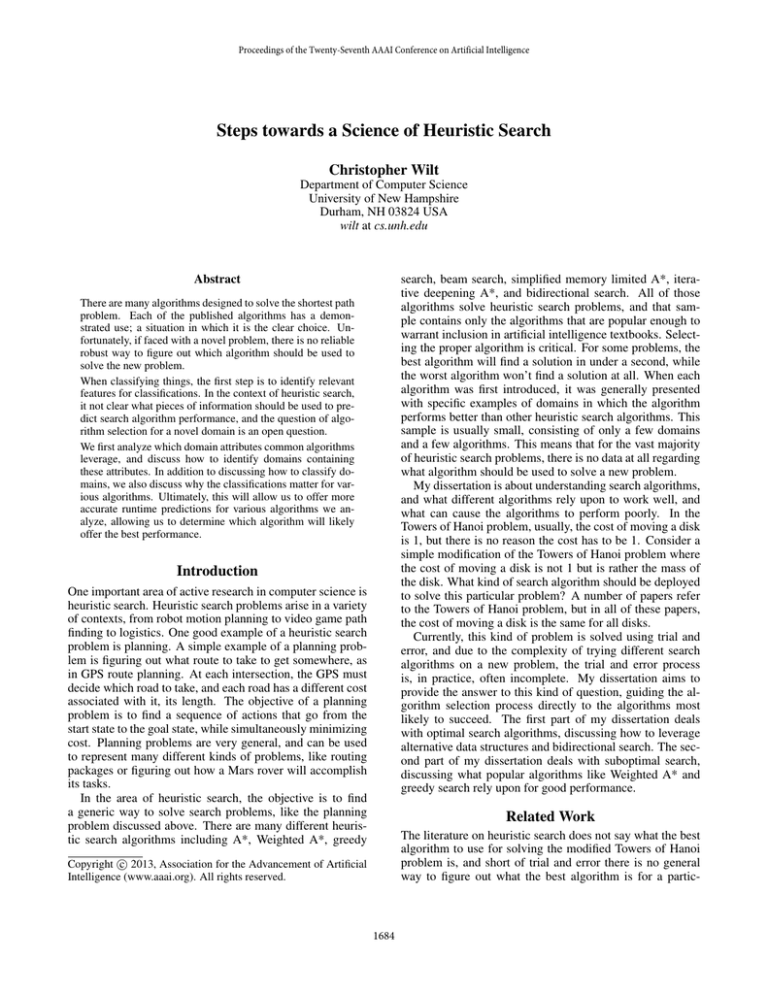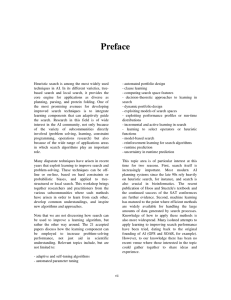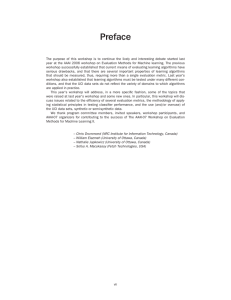
Proceedings of the Twenty-Seventh AAAI Conference on Artificial Intelligence
Steps towards a Science of Heuristic Search
Christopher Wilt
Department of Computer Science
University of New Hampshire
Durham, NH 03824 USA
wilt at cs.unh.edu
Abstract
search, beam search, simplified memory limited A*, iterative deepening A*, and bidirectional search. All of those
algorithms solve heuristic search problems, and that sample contains only the algorithms that are popular enough to
warrant inclusion in artificial intelligence textbooks. Selecting the proper algorithm is critical. For some problems, the
best algorithm will find a solution in under a second, while
the worst algorithm won’t find a solution at all. When each
algorithm was first introduced, it was generally presented
with specific examples of domains in which the algorithm
performs better than other heuristic search algorithms. This
sample is usually small, consisting of only a few domains
and a few algorithms. This means that for the vast majority
of heuristic search problems, there is no data at all regarding
what algorithm should be used to solve a new problem.
My dissertation is about understanding search algorithms,
and what different algorithms rely upon to work well, and
what can cause the algorithms to perform poorly. In the
Towers of Hanoi problem, usually, the cost of moving a disk
is 1, but there is no reason the cost has to be 1. Consider a
simple modification of the Towers of Hanoi problem where
the cost of moving a disk is not 1 but is rather the mass of
the disk. What kind of search algorithm should be deployed
to solve this particular problem? A number of papers refer
to the Towers of Hanoi problem, but in all of these papers,
the cost of moving a disk is the same for all disks.
Currently, this kind of problem is solved using trial and
error, and due to the complexity of trying different search
algorithms on a new problem, the trial and error process
is, in practice, often incomplete. My dissertation aims to
provide the answer to this kind of question, guiding the algorithm selection process directly to the algorithms most
likely to succeed. The first part of my dissertation deals
with optimal search algorithms, discussing how to leverage
alternative data structures and bidirectional search. The second part of my dissertation deals with suboptimal search,
discussing what popular algorithms like Weighted A* and
greedy search rely upon for good performance.
There are many algorithms designed to solve the shortest path
problem. Each of the published algorithms has a demonstrated use; a situation in which it is the clear choice. Unfortunately, if faced with a novel problem, there is no reliable
robust way to figure out which algorithm should be used to
solve the new problem.
When classifying things, the first step is to identify relevant
features for classifications. In the context of heuristic search,
it not clear what pieces of information should be used to predict search algorithm performance, and the question of algorithm selection for a novel domain is an open question.
We first analyze which domain attributes common algorithms
leverage, and discuss how to identify domains containing
these attributes. In addition to discussing how to classify domains, we also discuss why the classifications matter for various algorithms. Ultimately, this will allow us to offer more
accurate runtime predictions for various algorithms we analyze, allowing us to determine which algorithm will likely
offer the best performance.
Introduction
One important area of active research in computer science is
heuristic search. Heuristic search problems arise in a variety
of contexts, from robot motion planning to video game path
finding to logistics. One good example of a heuristic search
problem is planning. A simple example of a planning problem is figuring out what route to take to get somewhere, as
in GPS route planning. At each intersection, the GPS must
decide which road to take, and each road has a different cost
associated with it, its length. The objective of a planning
problem is to find a sequence of actions that go from the
start state to the goal state, while simultaneously minimizing
cost. Planning problems are very general, and can be used
to represent many different kinds of problems, like routing
packages or figuring out how a Mars rover will accomplish
its tasks.
In the area of heuristic search, the objective is to find
a generic way to solve search problems, like the planning
problem discussed above. There are many different heuristic search algorithms including A*, Weighted A*, greedy
Related Work
The literature on heuristic search does not say what the best
algorithm to use for solving the modified Towers of Hanoi
problem is, and short of trial and error there is no general
way to figure out what the best algorithm is for a partic-
c 2013, Association for the Advancement of Artificial
Copyright Intelligence (www.aaai.org). All rights reserved.
1684
difficult to solve, (Wilt and Ruml 2011). The other conclusion of this analysis was that algorithms that use estimates
of how many actions need to be used to get to the goal are
able to deal with the varying action costs. I will spend part
of the next academic year figuring out why this information
is so useful. This work will form the first subsection of the
part of my dissertation on suboptimal search.
One of the most popular suboptimal search algorithms,
Weighted A*, will sometimes fail catastrophically. In my
dissertation I will explain why the correlation between two
properties of states, named h (the estimated cost of getting
to a goal) and d* (the number of states on the shortest path
to a goal), could be used to predict if weighted A* would
fail (Wilt and Ruml 2012). The cause of the correlation (or
lack thereof) is not clear, and in the upcoming year, I will
analyze the relationship between h and d*, figuring out both
why some domains have a strong relationship between those
quantities, and why that relationship is so important to some
algorithms, but not to others.
ular problem. Other researchers have addressed the question of algorithm performance, but their analyses are generally limited to a specific class of algorithm or problem. For
example, Hoffmann (2005) discusses when a enforced hill
climbing will find a solution quickly, but only when solving
a STRIPS like planning problem. Zahavi et al. (2008) predicts the running time of iterative deepening A* (IDA*) on
domains with few duplicates, but knowing how hard IDA*
will have to work does not help unless you also know how
long other algorithms will take, and ignoring duplicates is
a very restrictive assumption, because in almost all heuristic search problems, there is more than one way to get to
at least one state (in the navigation example, there is almost always more than one way to go somewhere). Zhang
and Korf (1993) discuss the question of which linear space
search algorithm is best, comparing depth first branch and
bound and recursive best first search, and show when each
is best. This kind of analysis is extremely important, and
should be extended beyond selecting a linear space search,
because linear space searches are rarely used in practice,
because other algorithms are almost always faster. Xu et
al. (2008) discusses how to construct a boolean satisfability
solver through a portfolio approach. Among other things,
SATzilla figures out which solvers are likely to work well
on the instance at hand, and uses those algorithms. This
kind of work is important, and should be done for heuristic
search algorithms as well.
Conclusion
One of the most important aspects of science is understanding when a given technique should be used. Predicting
when a particular heuristic search algorithm is an appropriate choice is a difficult problem that is generally solved by
trial and error. What is needed is a precise science that will
replace this difficult and time consuming process.
With an understanding of which domain features are
leveraged by the various algorithms, we will be able to look
at new problems and identify whether or not they satisfy
the implicit assumptions the various algorithms make, ultimately allowing us to identify promising algorithms without
the difficult trial and error process that currently drives algorithm selection.
Dissertation Outline
My dissertation will be broken up into two main sections.
The first section will be about optimal heuristic search,
where I discuss algorithms that only return the cheapest solution that exists. Searching backwards from the goal can
dramatically reduce the required search effort, if the problem is amenable to that approach. Another area relating to
optimal heuristic search where I have done research is data
structures. Most heuristic search algorithms require a priority queue, but there are many different ways to create a
priority queue, each working best in a specific situation. I
describe how to choose a priority queue, as well as how
to switch between the queues dynamically for best performance without any a priori knowledge. I intend to finish this
section prior to attending AAAI.
The second section of my dissertation will deal with suboptimal heuristic search algorithms. I have already completed one survey of greedy search algorithms, experimenting with a wide variety of greedy search techniques on a
suite of six benchmark domains (Wilt, Thayer, and Ruml
2010). That work showed that one feature that makes a huge
difference is how much the different actions cost. Problems
where all the actions have exactly the same cost could be
solved by a variety of common search algorithms, but changing the problem so that some actions cost substantially more
than other actions caused the problems to be much more difficult, so much so that many algorithms were unable to find
solutions at all. After identifying the operator cost ratio as a
relevant feature, the next step was to determine exactly why
this feature made problems more difficult, which led to a
theorem explaining one reason why these problems are more
References
Hoffmann, J. 2005. Where ’ignoring delete lists’ works:
Local search topology in planning benchmarks. Journal of
Artifial Intelligence Research 24:685–758.
Wilt, C., and Ruml, W. 2011. Cost-based heuristic search is
sensitive to the ratio of operator costs. In Proceedings of the
Fourth Symposium on Combinatorial Search.
Wilt, C., and Ruml, W. 2012. When does weighted A*
fail? In Proceedings of the Fifth Symposium on Combinatorial Search.
Wilt, C.; Thayer, J.; and Ruml, W. 2010. A comparison
of greedy search algorithms. In Proceedings of the Third
Symposium on Combinatorial Search.
Xu, L.; Hutter, F.; Hoos, H. H.; and Leyton-Brown, K. 2008.
Satzilla: Portfolio-based algorithm selection for sat. J. Artif.
Intell. Res. (JAIR) 32:565–606.
Zahavi, U.; Feiner, A.; Burch, N.; and Holte, R. C. 2008.
Predicting the performance of IDA* with conditional distributions. In AAAI’08: Proceedings of the 23rd National Conference on Artificial Intelligence, 381–386. AAAI Press.
Zhang, W., and Korf, R. E. 1993. Depth-first vs. best-first
search: New results. In Proceedings of AAAI-93, 769–775.
1685






